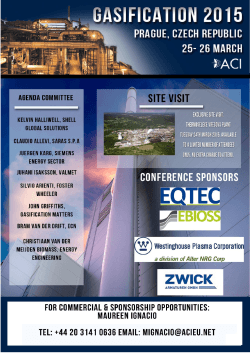
Waste to Energy - New Technologies March 28, 2012
Waste to Energy - New Technologies March 28, 2012 Understanding the Energy Market • Power Generation – – – – Coal Natural Gas Oil Renewables o Hydro, Biomass, Wind, Solar, Geothermal, Waste to Energy (WTE) – Nuclear • Transmission/Distribution – Gas & Electric 2 North American Renewable Energy Market Note Source: EIA Data Base 2009 3 Latin American and Caribbean Market • Predicted Annual Growth Rate 9% • Municipal, Utilities & Private Developers – 513 projects totaling $230 billion – An additional 7,500 MW are under development – More than 800 Hydro electric projects are being developed requiring $53 billion investment – 300 natural gas units totaling 27 GW • Caribbean dependent on No.2 Diesel forces renewable development $2.0 billion committed !EIA and Industrial Info Resources 2010 - 2015 Renewable Energy • What is Renewable Energy? • According to the U.S. EPA – Renewable energy is energy obtained from sources that are essentially inexhaustible unlike natural gas, coal and oil, of which there is a finite supply. • According to the U.S. DOE – Renewable energy sources include: wood and other biomass, solar (Photovoltaic and Thermal), wind, geothermal, wastes [Municipal Solid Waste (MSW), Refuse-Derived Fuel (RDF) and Landfill Gas (LFG)] and any other sources that are naturally or continually replenished.” – By definition, the DOE describes renewable energy as a “nondeplete-able source of energy.” 5 Putting MSW into Perspective • 4.43 pounds per day of MSW per person in the U.S. – Equates to 1.329 billion pounds per day • 1 waste (used) tire per person per year – Equates to over 300 million per year Source: U.S. EPA 6 Growth in MSW Generation Source: U.S. EPA 7 MSW Makeup 83% carbon w/plastics and Textiles piece, 62% without Source: U.S. EPA 8 Feedstock Comparisons % Moisture % Ash % Volatile Matter % Fixed Carbon Btu/lb Used Tires 2 3 80 85 15,369 Plastic 2 2 96 60 14,100 Pet Coke 8 0.5 10 81 14,050 Bituminous Coal 12 11 35 61 11,100 Poplar 5 1 82 47 8,382 Subbituminous Coal 30 5 31 48 8,156 Corn Stover 6 5 76 44 7,782 Paper 10 5 76 44 6,814 Pine 17 0.5 71 42 6,800 Switchgrass 8 4 67 39 6,636 Chicken Litter 12 19 58 32 6,310 MSW 21 25 52 52 5,000 Biosolids 5 53 40 20 3,445 Current WTE Technologies • • • • • • • • Combustion (Mass-burn Incineration and RDF) Pyrolysis Gasification Plasma Gasification Hydrolysis Anaerobic Digestion Steam Hydrogasification Methane/Landfill Gas (Electric & Pipeline gas) This Presentation Covers Technologies in Green! 10 The Ideal Waste Treatment System 1. 2. 3. 4. A closed system, not open to the air, water, or land A system that will handle large volumes of wastes economically A system that can process a broad spectrum of wastes A destruction level of 99.9999% (or to the detection limit), or transformation to an inert state 5. No operator exposure 6. No odor 7. No acid off-gases 8. No toxic ash 9. No uncertain storage of organic or toxic substances by land filling or deep well injection 10. No ocean or waterway dumping of waste • Note! All technologies presented make these claims but we opine that this is not possible. *EPA – DOE – DOD 11 Pyrolysis • Thermochemical decomposition of organic material at elevated temperatures without the participation of oxygen • It involves the simultaneous change of chemical composition and physical phase, and is irreversible • Pyrolysis occurs at temperatures of >550°F with a complete lack of oxygen • Can be used to produce syngas or liquid hydrocarbons • By-product is unconverted carbon char (charcoal) 12 Fast Pyrolysis 13 Rapid Thermal Process 14 Pyrolysis Comparison 15 Gasification Feedstock Power Fuels Chemical Fertilizers 16 Gasification • Thermal conversion of organic materialsat 1,0002,800°F, with a limited supply of air or oxygen (substoichiometric atmosphere) • Not combustion, there’s no burning! • Gasification uses only a fraction of the air/oxygen that would be needed to combust the material and thus creates a low to medium Btu syngas • NOTE! Although more mature than other processes, it requires complex systems and gas clean up equipment 17 Syngas • Syngas contains mostly hydrogen (H2) (Water shift reaction), carbon monoxide (CO), carbon dioxide (CO2), and water (H2O) – it’s not methane (CH4), like natural gas • Heating value is 125-360 Btu/scf – vs. natural gas at 1,000 Btu/scf • Syngas can be used as fuel for generating power, or to make chemicals and fuels 18 Gasifiers – Many Types for Different Feedstocks and Applications 19 Gasifiers • Typical commercial gasifiers: – – – – – – 750 to 1-150 tons/day Air/Oxygen-blown Atmospheric pressure 1,000-2,500ºF Fixed bed or fluid bed Syngas is combusted directly in a boiler to make steam for a steam turbine generator or a Combustion Turbine/Engine Genset 20 Plasma Gasification • Uses plasma torch or arc using carbon electrodes, copper, tungsten, hafnium, zirconium, etc. to initiate gasification reactions • Plasma temperature 4,000 - 20,000ºF (More sensible heat) • Used for decades to destroy wastes and melt incinerator ash into slag/glass • Good for hard to gasify materials 21 MSW Plasma Gasification 22 Plasma Gasification History • First Unit online 1985 – Anniston, Alabama with Catalytic Converter System – Munitions destruction • Second Unit online 1995 – Kinura, Japan followed by the third unit in Bordeaux, France – Both MSW • Other facilities in Sweden, Norway, Canada, Taiwan, U.S. and numerous others in Japan. 23 Plasco System Diagram 24 Plasma Waste Recycling, Inc. • 250 tons/day design for MSW plasma gasification to power 25 WSE System 26 Typical Plant Layout 27 MSW Plasma Gasification and Pyrolysis • Pyrolysis requires pre-processing Plasma Arc does not – Removal/recovery of metals, paper, and glass, plastics plus shredding and sizing – Enhances existing recycling programs • Same technologies as used for biomass – Some use pyrolysis – Plasma gasification in some applications • Each technology has better environmental performance than incineration 28 Hydrolysis Hydrolysis hydro "water" + lysis "separation” is a chemical reaction during which molecules of water (H2O) are split into hydrogen cations (H+, conventionally referred to as protons) and hydroxide anions (OH−) in the process of a chemical mechanism 29 Typical Hydrolysis Process 30 Clean Water Out Waste In air 99.4% Heat Recovered to Electricity cased well (900 to 2500 psi) Heat Exchange Reaction Zone 31 (3,000 to 7,000 ft) Steam Hydrogasification • The process of combining steam, hydrogen and MSW to generate a higher quality of syn-gas • Generally temperatures above 900°F • Process requires complex systems and equipment 32 Typical Steam Hydrogasifier Process 33 Conclusions for Proven Technologies • Combustion – Proven – Emissions (MACT) – Capital Increases - Odor • Gasification – Proven – Higher Capital – Higher O&M – Better Emissions • Anaerobic Digestion – Proven - MSW can contaminate the organisms – emissions OK – Capital & O&M competitive – Size constrained (requires multiple digesters) • Landfill Gas – Proven – Low Capital & O&M costs – emissions OK – requires flaring on occasion – can be high in N2 and arsenic – requires significant land quantities – not Island friendly 34 Conclusions for New Technologies • Pyrolysis – Transportation or Island driven where diesel oil is an issue – technically feasible - No large scale operating – Scale up??? – Carbon/Charcoal • Plasma Arc – Some experience -Type dependent (flame/electrode) – parasitic load – best emissions – Scale up? – Solids are benign – capital & O&M costs need detailed evaluation • Hydrolysis – Commercial operation ? – Scale up? – emissions good – capital & O&M costs ??? – Close to zero discharge – creates drinkable water. • Steam Hydrogasification – No large scale experience – requires H2 – Complex – Capital & O&M costs ??? – HP Steam costs??? 35 Thank You 36 Contact Info Tom Stringfellow Denver, CO 720-286-0454 Thomas.Stringfellow@ch2m.com 37
© Copyright 2025





















